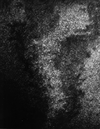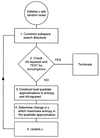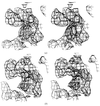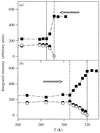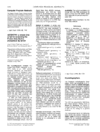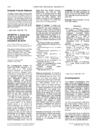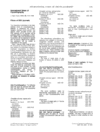issue contents
December 1999 issue

Cover illustration: Simulated diffraction pattern for a two-dimensionally disordered decasil (porous SiO2) calculated using a fast recursive algorithm. The plane is perpendicular to c with the reciprocal index l = 1; the error probability is 0.5 and the intensities are scaled to 25% of the highest value. Courtesy of Peter Daniels.
research papers
A new electron diffractometer for precise measurement of diffraction patterns has been developed. The accuracy of the measurements was checked by a comparison with Hartree–Fock calculations.
Effective pair interaction potentials of Co–Pt alloy have been obtained from X-ray diffuse scattering measurements on short-range ordered Co3Pt and Co65Pt35 single crystals.
Scattering intensity in the azimuthal plane for crystals with one and two sets of different-type dislocation walls, causing local rotations in the lattice, was analysed. The conditions necessary for the splitting of the reflection into spikes during a high extent of deformation are considered.
A detailed X-ray line-profile analysis is presented on five compositions of Pb–Sn alloys in the face-centred cubic (f.c.c.) α phase.
A model-independent maximum-entropy method is presented which can be used to extract structural information from small-angle X-ray diffraction data of disordered systems. The method is explicitly applied to perfluorinated ionomer membranes and liquid-crystalline polymers.
The first refinement of a protein crystal structure using a combination of high-resolution synchrotron X-ray powder diffraction data and stereochemical restraints is described. The resulting crystal structure for metmyoglobin is in accord with previous single-crystal determinations.
Glass ceramics have been studied by X-ray absorption spectroscopy and differential anomalous X-ray scattering techniques.
The analytic expression for the correlation function of the cuboid with edges a, b, c is calculated, based on the chord-length distribution of this figure. Different checks (scattering intensity, invariant, asymptotic expansion of the scattering intensity) are performed to validate the result.
The orientation relationship between Al6Mn precipitates that form during continuous recrystallization of supersaturated Al–1.3% Mn and the Al matrix are analysed by means of transmission electron microscopy and selected-area diffraction.
X-ray reticulography displayed the two-dimensional pattern of slight doming of lattice planes in the central surface area of a mesa generated by a localized implant of fluorine ions of 17 MeV energy. Large radii of curvature of lattice planes were reliably measured under conditions when two-beam optical interferometry revealed no departure from flatness of the crystal surface.
A method avoiding specimen rotation is developed for determining local crystal orientations in heterogeneous materials such as wood. Equations are derived and data evaluation procedures are described.
The structural properties of (001)- and (111)-oriented p+-type porous silicon samples have been investigated using X-ray techniques.
A parallel-slit analyzer has been developed for the purpose of lowering tails in diffraction profiles. It is shown that textured and roughened surfaces of foil materials are considered effective for depressing total reflection effects from the surfaces, and consequently for lowering the tails of diffraction peaks.
The optimization of parameters for BBB X-ray interferometers is discussed and a new geometric layout, designed for detailed investigations of intrinsic interference patterns, is presented. The gravitational force acting on the interferometer is shown to result in built-in interference fringes.
Inelastic neutron scattering has been measured for various materials that can be used as incoherent-scattering calibrants in small-angle neutron scattering (SANS) measurements. The apparent discrepancies in intensity measurements using different detectors are explained by the combination of extensive inelastic scattering and wavelength-dependent detector efficiency.
teaching and education
Free 

A series of interactive Java applets accessible on the web are presented with the aim to illustrate and facilitate the understanding of symmetry and diffraction concepts.
computer programs
A fast direct-space method for crystal structure determination from powder diffraction patterns has been implemented within the Cerius2 (Molecular Simulations Inc.) molecular-modelling package. For structure solution, it employs a simulated-annealing algorithm in combination with rigid-body Rietveld refinement.
laboratory notes
The phasing power of Fe within [FeS] clusters was extended from 4 to 2.5 Å resolution by placing model [4Fe4S] clusters at the locations of the 4-Fe superatoms used for low-resolution phasing.
Simple modifications to a MAR 345 detector which facilitate the collection of very low resolution data are described. With these modifications, the lowest order reflections from a poliovirus crystal (c = 377.1 Å) were observed, and measurement of all reflections in typical protein cells should be routine.
fast communications
The structural evolution of LiMn2O4 spinel has been followed from 320 K down to 10 K.
computer program abstracts
A simple Unix script for accessing the Protein Data Bank's anonymous ftp server is described.
crystallographers
Free 

international union of crystallography
Free 



 journal menu
journal menu










